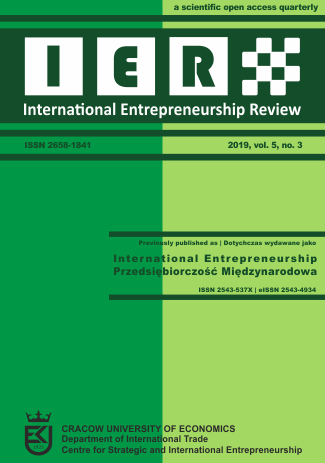Market and marketing within the concept of functioning and development of cultural heritage sites

Abstract
Objective: The article presents the conditions, factors, and stages of development of the market orientation of cultural heritage objects. The author introduced a terminological distinction – the cultural potential of the object and its market potential. The market potential is understood as the ability to generate revenues from commercial activities (products and services).
Research Design & Methods: The conceptual nature of the article determined the scope of methods used in diagnosing, analyzing, and synthesizing the phenomena and processes discussed. These were primarily critical literature studies, which usually limited considerations of the market role of cultural heritage objects to the cases of museum institutions and their tourist functions.
Findings: Developing and organizing knowledge about the market concept of the functioning of cultural heritage objects, as well as indicating the main directions in the strategic marketing management of these objects. Besides, the paper points out the relationship between the cultural potential and market potential of historic buildings and outlines its significance.
Contribution & Value Added: The presented concept of market orientation of cultural heritage objects breaks with the narrow understanding of the market of these objects and its only marginal role in generating development factors. The sustainable development of historic buildings should be focused on a balance between its functional goals (protection and conservation), socio-civilization goals, and economic ones.
Keywords
cultural heritage, heritage marketing, heritage industry, heritage tourism, marketing of museum, market orientation of culture, economic of culture
Author Biography
Andrzej Szromnik
Full Professor at the University of Economics in Krakow and the State University of Technology and Economics in Jarosław. Dr hab. economic sciences in the field of management. Areas of scientific, research and teaching interest – Place Marketing, Marketing Research, Management of Retailing, Marketing Management. Lecturer at the Academy of Heritage – Cultural Heritage Post-
Graduate Program (International Center of Culture in Krakow).
References
- Barański, R. (2016). Finansowanie działalności kulturalnej. Warszawa: C.H.Beck.
- Chhabra, D. (2010). Sustainable marketing of cultural and heritage tourism. London-New York: Routledge.
- Cenderello, A. (2015). Marketing of heritage sites. Received from http://www.interpret-europe.net/fileadmin/Documents/projects/HISA/HISA_Marketing_Heritage_sites.pdf in May, 2019
- Dominguez, V.R. (1986). The Marketing of Heritage. Journal of the American Ethnological Society, 13(3), 546-555.
- Dragičevič-Šečič, M. & Stojkovič, B. (2010). Kultura: zarządzanie, animacja, marketing. Warszawa: NCK.
- Jung, B. (Ed.) (2011). Ekonomika kultury. Od teorii do praktyki. Warszawa: NCK, Instytut Adama Mickiewicza.
- French, Y., & Runyard, S. (2011). Marketing and Public Relations for museums, galleries, cultural and heritage attractions. London-New York: Routledge.
- Fullerton, L., McGettigan, K. & Stephens, S. (2010). Integrating management and marketing strategies at heritage sites. International Journal of Culture, Tourism and Hospitality Research, 4(2), 108-117.
- Herbert, D.T., Prentice, R.T., & Thomas, C.J. (1989). Heritage sites: strategies for marketing and development. Aldershot, Hants: Avebury.
- Ilczuk, D. (2012). Ekonomika kultury. Warszawa: Wydawnictwo Naukowe PWN.
- Łodziana-Grabowska, J., & Wiktor, J.W. (Eds.) (2014). Koncepcje zarządzania i marketingu w sferze kultury – projektowanie, implementacja i kontekst skuteczności działań. Warszawa: CeDeWu.
- Knecht, Z., & Styś A. (Eds.) (1990). Marketing w działalności instytucji i jednostek upowszechniania kultury. Warszawa: Wydawnictwo Spółdzielcze.
- Kopeć, K.D. (2014). Finansowanie kultury w ramach społecznej odpowiedzialności biznesu. Kraków: LIBRON.
- Kotler, N.G., Kotler, Ph., & Kotler, W.I. (2008). Museum Marketing and Strategy. Desining, Missions, Building Audiences, Generating Revenue and Resources. San Francisco: Jossey Bass.
- Kowalczyk, W. (1995). Marketing w muzeum. Muzealnictwo, 37, 10-20.
- Matt, G. (2006). Muzeum jako przedsiębiorstwo. Łatwo i przystępnie o zarządzaniu instytucją kultury. Warszawa: Fundacja Aletheia.
- Mazurek-Łopacińska, K. (Ed.) (1997). Kultura w gospodarce rynkowej – problemy adaptacji marketingu. Warszawa-Wrocław: AE Wrocław.
- Mc Lean, F. (1997). Marketing the museum. London-New York: Routledge.
- Misiura, S. (2006). Heritage Marketing. Oxford: ELSEVIER Ltd.
- Montemaggi, M., & Severino, F. (2007). Heritage Marketing – La storia Dell’ Impresa Italiana come vantaggio competitive. Milano: Franco Angeli.
- Murzyn-Kupisz, M. (2010). Barbarzyńca w ogrodzie? Dziedzictwo kulturowe widziane z perspektywy ekonomii. Zarządzanie Publiczne, 13(3), 19-32.
- Murzyn-Kupisz M. (2016). Instytucje muzealne z perspektywy ekonomii kultury. Kraków: Universitas.
- Napolitano, M.R., & De Nisco, A. (2017). Cultural heritage: the missing “link” in the place marketing literature “chain”. Place Branding and Public Diplomacy, 13(2), 101-106.
- Niemczyk, A. (2007). Marketing w sferze kultury – wybrane problemy. Kraków: AE Kraków.
- Parowicz, I. (2019). Cultural Heritage Marketing. A Relationship Marketing Approach to Conservation Services. London: Palgreve Pivot.
- Parsons, E. (2008). Non-profit Marketing. New York: SAGE Publications Ltd.
- Simm, C. (2006). Besucherorientiertes Museumsmarketing – Hintergmende und Finanzierung. Saarbrücken: VDM Verlag Dr. Müller.
- Smoleń, T. (2013). Marketing w tworzeniu wartości dla klienta na rynku dóbr kultury – na przykładzie oferty muzeum. Handel Wewnętrzny, t. I, ed. spec., 263-269.
- Sobocińska, M. (2015). Uwarunkowania i perspektywy rozwoju orientacji rynkowej w podmiotach sfery kultury. Wrocław: UE Wrocław.
- Starr, F. (2013). Corporate responsibility for cultural heritage: conservation sustainable development and corporate reputation. New York-London. Routledge.
- Thorburg, A. (1986). Marketing cultural heritage. Does it work within Europe?. Travel & Tourism Analyst, December, 39-48.
- Throsby, D. (2010). Ekonomia i kultura. Warszawa: NCK.
- Towse, R. (2011). Ekonomia kultury. Kompendium. Warszawa: NCK.
- Wróblewski, Ł. (2012). Strategie marketingowe w instytucjach kultury. Warszawa: PWE.
